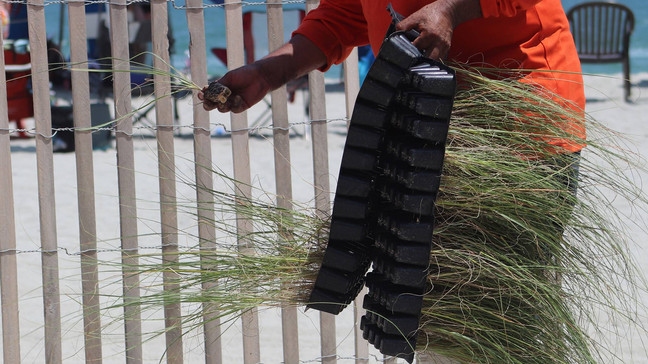Boosting Scotland's Coastline: New Seagrass Planting Initiatives

Table of Contents
The Importance of Seagrass Meadows in Scotland
Seagrass meadows are often overlooked, yet they are vital components of Scotland's marine environment, playing a crucial role in both biodiversity and coastal protection.
Biodiversity Hotspots
Seagrass meadows are incredibly biodiverse habitats, acting as nurseries and feeding grounds for a vast array of species. These underwater grasslands support a complex food web, contributing significantly to the overall health of Scotland's marine ecosystem.
- Key Species: Scottish seagrass meadows are home to commercially important fish species like cod and plaice, shellfish including scallops and cockles, and numerous crustaceans. They also provide vital habitat for more charismatic species such as seahorses, various crab species, and even harbour seals, which utilize seagrass beds for shelter and foraging.
- Nursery Grounds: The dense structure of seagrass provides shelter for juvenile fish and invertebrates, protecting them from predators and providing a safe environment to grow and develop. This crucial role in the life cycle of many species makes seagrass meadows essential for maintaining healthy fish populations.
Coastal Protection and Carbon Sequestration
Beyond their contribution to biodiversity, seagrass meadows offer significant benefits in terms of coastal protection and carbon sequestration.
- Natural Coastal Defence: Seagrass meadows act as a natural buffer against erosion, absorbing wave energy and reducing the impact of storms on the coastline. Their root systems stabilize sediments, preventing coastal retreat and protecting valuable coastal habitats and infrastructure.
- Blue Carbon Storage: Seagrass is remarkably efficient at sequestering carbon dioxide from the atmosphere, storing it within its tissues and sediments. Studies suggest that seagrass ecosystems store carbon at a rate comparable to, or even exceeding, that of tropical rainforests, making them incredibly valuable in the fight against climate change. This “blue carbon” stored in seagrass meadows is critical for mitigating the effects of climate change and improving water quality.
Current Seagrass Planting Initiatives in Scotland
Several exciting seagrass planting initiatives are currently underway across Scotland, demonstrating a growing commitment to marine conservation and coastal restoration.
Location and Scale of Projects
Numerous organizations are collaborating on ambitious seagrass restoration projects across Scotland's diverse coastline. These initiatives vary in scale and approach but share a common goal: to restore degraded seagrass meadows and enhance the health of Scotland's marine environment.
- Specific Projects: Examples include projects in the Firth of Clyde, led by [mention specific organizations involved, e.g., the Marine Conservation Society and local universities], focusing on transplanting seagrass shoots. Other initiatives, such as those in the Moray Firth, concentrate on seed dispersal techniques, aiming to cover larger areas more efficiently. [Insert details on specific project locations and areas covered].
- Planting Methods: Restoration techniques include both transplanting mature seagrass shoots and broadcasting seeds. The choice of method depends on factors such as the scale of the project, the availability of seed or shoots, and the specific characteristics of the restoration site.
Funding and Collaboration
The success of these large-scale seagrass restoration projects relies heavily on securing adequate funding and fostering strong collaborations between various stakeholders.
- Funding Sources: Funding for these initiatives comes from a variety of sources, including government grants (e.g., from NatureScot), private donations, and funding from charitable trusts dedicated to marine conservation.
- Collaborative Efforts: Successful seagrass planting requires collaboration between scientists, conservation organizations, government agencies, local communities, and potentially even private businesses. This collaborative approach ensures that projects are well-planned, executed effectively, and sustainably managed over the long term.
Challenges and Future Outlook for Seagrass Restoration in Scotland
Despite the positive momentum, significant challenges remain in achieving widespread seagrass restoration in Scotland.
Environmental Threats
Seagrass meadows face numerous threats, hindering natural recovery and requiring ongoing conservation efforts.
- Pollution: Runoff from agriculture and sewage discharge introduce pollutants like excess nutrients and chemicals, which can harm seagrass growth and survival. Sedimentation from coastal development further smothers seagrass beds, reducing light availability for photosynthesis.
- Climate Change: Rising sea temperatures, ocean acidification, and increased storm frequency all pose significant threats to seagrass meadows. These changes can alter the distribution and abundance of seagrass, making them more vulnerable to disease and other stressors.
Monitoring and Long-Term Success
Long-term monitoring is crucial to assess the effectiveness of seagrass planting initiatives and to inform future restoration strategies.
- Monitoring Techniques: Regular monitoring of planted seagrass meadows involves a range of techniques, including underwater visual censuses, remote sensing using drones and satellites, and sediment core analysis. This data provides critical information about growth rates, survival rates, and overall ecosystem health.
- Adaptive Management: The data collected through monitoring informs adaptive management strategies. This allows researchers and practitioners to adjust planting techniques, address emerging challenges, and refine restoration approaches to maximize the long-term success of the projects.
Conclusion
Seagrass planting initiatives are absolutely critical for boosting Scotland's coastline, restoring vital habitats, and enhancing the biodiversity of our marine environment. These projects offer numerous benefits, not only protecting our precious marine ecosystems but also contributing to climate change mitigation and safeguarding coastal communities. By continuing to fund and support these crucial initiatives, and by raising awareness about the importance of seagrass, we can ensure the long-term health and prosperity of Scotland's exceptional coastline. Get involved and learn more about how you can contribute to seagrass restoration projects in Scotland – help us boost Scotland’s coastline and protect our precious seagrass meadows!

Featured Posts
-
 Corinthians X Sao Bernardo Horario Do Jogo E Onde Assistir
May 05, 2025
Corinthians X Sao Bernardo Horario Do Jogo E Onde Assistir
May 05, 2025 -
 Gigi Hadid And Bradley Cooper Instagram Official With Kissing Photo
May 05, 2025
Gigi Hadid And Bradley Cooper Instagram Official With Kissing Photo
May 05, 2025 -
 Patrick Beverleys Russell Westbrook Post Goes Viral A Deeper Look
May 05, 2025
Patrick Beverleys Russell Westbrook Post Goes Viral A Deeper Look
May 05, 2025 -
 Mc Gregors Sparring Partner Knocked Out Ufc Bogeymans Controversial Seven Fight Winning Streak
May 05, 2025
Mc Gregors Sparring Partner Knocked Out Ufc Bogeymans Controversial Seven Fight Winning Streak
May 05, 2025 -
 Limited Public Consultation On Key French Defense Strategies
May 05, 2025
Limited Public Consultation On Key French Defense Strategies
May 05, 2025
